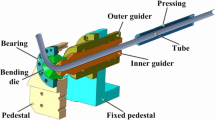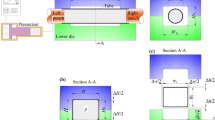Abstract
Three-dimensional free-bending is a new and an advanced forming technology to manufacture the complex metal hollow components with continuously varying radius. In this study, the principle, process analysis, and the CNC control of free-bending were introduced in detail. The characteristics of the free-bending process, such as the motion trace scope of bending die and the stress variation in the free-bending process, were numerically investigated through finite element method using ABAQUS finite element code. With the simulation model, the material correction factor (Km) of copper was determined and the correction factor (Kc) for the clearance between the tube and bending die was also proposed. Moreover, the effects of the key process parameters including the clearance between the tube and bending die (Δc), the distance between the center of the bending die and the head of guide sleeve (A), and the axial feeding velocity (v) on the forming quality of the tubular bending components were studied as well. Through the finite element simulation and analysis, the optimum parameters (Km, Kc, Δc, A, and v) used in the free-bending process of the tubular component are summarized and the forming process design of the copper tubular component was also obtained. Based on the forming process design, the simulation and bending test of the copper tubular component were carried out, and the dimensions of the bending components gave a very good agreement with the results obtained from finite element modeling. Furthermore, there was no obvious cross section distortion, excessive thickening, and thinning of wall thickness of the formed tubular components. It is concluded that the three-dimensional free-bending technology is a novel forming process used to manufacture a sound complex three-dimensional hollow component with asymmetric cross sections and continuous varying radii.
Similar content being viewed by others
References
Gensch F, Gall S, Fahrenson C, Müller S, Reimers W (2016) Characterization of weld seam properties of extruded magnesium hollow profiles. J Mater Sci 51(8):3888–3896
Hermes M, Staupendahl D, Becker C, Tekkaya AE, Staupendahl D (2011) Innovative machine concepts for 3D bending of profiles and tubes. Key Eng Mater 473:37–42
Zhang C, Li H, Li M (2016) Detailed analysis of surface asperity deformation mechanism in diffusion bonding of steel hollow structural components. Appl Surf Sci 371:407–414
Heng L, Shi KP, Yang H, Tian YL (2012) Springback law of thin-walled 6061-t4 al-alloy tube upon bending. Trans Nonferrous Metals Soc China 22(Suppl 2):s357–s363
Guo XZ, Jin K, Wang H, Pei W, Ma F, Tao J, Kim N (2016) Numerical simulations and experiments on fabricating bend pipes by push bending with local induction-heating process. Int J Adv Manuf Technol 84(9):2689–2695
Murata M, Kuboki T (2015) CNC tube forming method for manufacturing flexibly and 3-dimensionally bent tubes. Springer, Berlin, pp 363–368
Liang JC, Song G, Fei T, Yu PZ, Song XJ (2014) Flexible 3D stretch-bending technology for aluminum profile. Int J Adv Manuf Technol 71:1939–1947
Gantner P, Harrison DK, Silva AKMD, Bauer H (2004) New bending technologies for the automobile manufacturing industry. Proc Int Matador Conf:211–216
Li P, Wang L, Li M (2016) Flexible-bending of profiles and tubes of continuous varying radius. Int J Adv Manuf Technol:1–7
Li P, Wang L, Li M (2016) Flexible-bending of profiles with asymmetric cross-section and elimination of side bending defect. Int J Adv Manuf Technol 87:1–7
Murata M, Ohashi N, Suzuki H (1989) New flexible penetration bending of a tube: 1st report, a study of MOS bending method. Trans Jpn Soc Mech Eng C 55:2488–2492
Murata M (1996) Effects of inclination of die and material of circular tube in MOS bending method. Trans Jpn Soc Mech Eng C 62:3669–3675
Murata M (1996) Effect of die profile and aluminum circular tube thickness with MOS bending. J Jpn Inst Light Met 46:626–631
Gantner P, (2008) The characterisation of the free-bending technique. Glasgow Caledonian University
Gantner P, Harrison DK, De Silva AK, Bauer H (2007) The development of a simulation model and the determination of the die control data for the free-bending technique. Proc Inst Mech Eng B J Eng Manuf 221:163–171
Germany J. NEU freebending machine [EB/OL]. http://www.etaitech.com/about/? 118.html
Yang X, Choi C, Sever NK, Altan T (2016) Prediction of springback in air-bending of advanced high strength steel (dp780) considering young′s modulus variation and with a piecewise hardening function. Int J Mech Sci 105(1–2):266–272
Gantner P, Bauer H, Harrison DK, Silva AKMD (2005) Free-bending—a new bending technique in the hydroforming process chain. J Mater Process Technol 167:302–308
Nissin Technical. See http://www.nissin-precision.com/english/sindex.html
Heng L, Yang H (2011) A study on multi-defect constrained bendability of thin-walled tube CNC bending under different clearance. Chin J Aeronaut 24(1):102–112
Neu J, Eins links, eins rechts (2004) One left, one right – free-bending with a CNC-5-axis-tube bending machine. Maschinen Markt das Industrie Magazin 49:22–23
Gantner P, Bauer H (2004) Fea—simulation of bending processes with ls-dyna
Arreaga G, Capovilla R, Guven J (2001) Frenet-serret dynamics. Classical Quantum Gravity 18(23):5065–5083
Acknowledgements
This study was supported by the China Aviation Science Foundation (No. 2016ZE52047).
Author information
Authors and Affiliations
Corresponding authors
Rights and permissions
About this article
Cite this article
Guo, X., Xiong, H., Xu, Y. et al. Free-bending process characteristics and forming process design of copper tubular components. Int J Adv Manuf Technol 96, 3585–3601 (2018). https://doi.org/10.1007/s00170-018-1788-1
Received:
Accepted:
Published:
Issue Date:
DOI: https://doi.org/10.1007/s00170-018-1788-1




